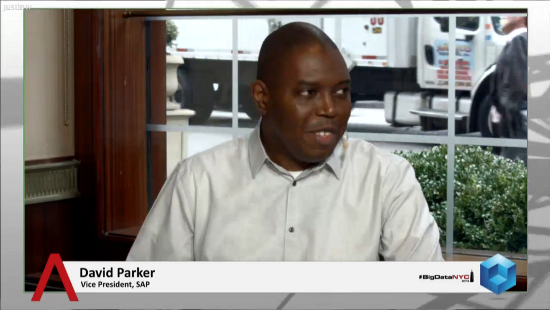 NEWS
NEWS
 NEWS
NEWS
 NEWS
NEWS
David Parker, Vice President at SAP, discussed his company’s Big Data strategy, the evolution of HANA, and enterprise data applications, with theCUBE co-hosts Jeff Kelly and John Furrier, live at #BigDataNYC 2013 in New York.
![]()
“First and foremost, we’re an application company,” Parker stated. SAP’s Big Data approach was powered by its customers who need solutions for their challenge of storing vast, large quantities of data, “which naturally gravitates towards a Hadoop cluster.”
SAP HANA is the flagship product the company uses to drive application development. “The Big Data world is somehow owned by Hadoop,” Parker said. Unstructured data needs to be collected and merged with enterprise data – CRM, books and records.
“How we go to market is all around customer choice” and focusing on use cases that make a difference. “We are database and data source agnostic,” Parker said. SAP currently focused on 25 different industries.
“We had to build Big Data specific applications,” Parker stated. The company today launched four new Big Data applications focusing on fraud management and customer experience intelligence, the later focusing on buying profiles of customers based on how they interact via social media. By allowing customers to store this type of data and merge it with customer data from leads to better insights into customer behavior analysis.
HANA powers “the concept of smart data access – data federation, data query. A query can go directly into HANA,” Parker explained, which sees where the data is stored, runs a query directly into Hadoop when needed and run MapReduce tasks on it. The users get the answer, without knowing where the data is coming from.
The company also focuses on the new SAP Lumira, a self-service analytical tools that empowers users to use granular data, which can be both historical and transactional data.
Asked how customers perceived Big Data, Parker said “they are not aware that Big Data exists. All they know is that they have a data challenge.” The problem can be the variety or velocity of the data. “They don’t actually understand the concepts behind ‘what do I need to build a Big Data platform,'” and educating them in terms of what the market is doing and what the company in their industry are doing is very important.
Once they understand the use cases, they think about the technology they need. “Once they understand what value they derive from the data, we turn that into information for them, and they turn it into knowledge.” The process focuses on how to understand your data, understand what you can do with it, then become empowered on what you can do for your business.
Commenting on how SAP evolved to a point where HANA became central to its strategy, coming from the ERP world and transitioning into analytics and BI, Parker said “it’s been an exciting change for us, a refreshing change. We looked at what the customers asked us for, and kept an eye on the vision of the company.”
A major trend was the move from on-premise to cloud based solutions. “We now have a HANA enterprise cloud environment. We use HANA to drive our own systems internally in the cloud.” Another major point of focus was the mobility aspect and how it relates to data. It is key to derive consistent analytics from applications and make it available on demand in the cloud.
Support our mission to keep content open and free by engaging with theCUBE community. Join theCUBE’s Alumni Trust Network, where technology leaders connect, share intelligence and create opportunities.
Founded by tech visionaries John Furrier and Dave Vellante, SiliconANGLE Media has built a dynamic ecosystem of industry-leading digital media brands that reach 15+ million elite tech professionals. Our new proprietary theCUBE AI Video Cloud is breaking ground in audience interaction, leveraging theCUBEai.com neural network to help technology companies make data-driven decisions and stay at the forefront of industry conversations.